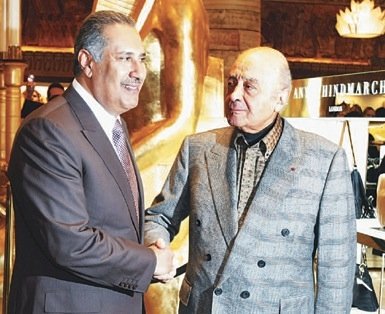The lunch of a life-time is coming up and in all of London there couldn’t be a more deserving location than that of Harrods, the most famous luxury department store in the UK and in the world. This leadership goes back to 1834, when the founder, Charles Henry Harrod from Essex, opened his first shop on Cable street, in the Eastern suburbs of London. Fifteen years later, in 1849, the big leap was made to number 8, Middle Queen’s Buildings, today’s Brompton Road, in the heart of Knightsbridge, along the Southern border of Hyde Park.

May 2010: the Egyptian businessman Mohamed Al Fayed (on the right) just sold Harrods Department Store to the prime minister of Qatar, sheikh Hamad Bin Jassim Bin Jabr Al-Thani (on the left) for 1,5 bilion pounds
In the beginning, 2 assistants worked with Sir
Charles, from 7 in the morning until 8 in the evening, 6 days a week. In 1880 there were already 100 employees and in 2013 they’re 5 thousand, with peaks of 6,400 during sales and at Christmas, what is left of 25 thousand interviews conducted over a year by the human resources management. These workers hold passports from 86 different countries. These are huge figures to which we add the following:
25: hectares, the total surface dedicated to sales;
7: floors;
150: the depth of the
3 water wells which guarantee
millions of litres every year;
35: lifts which every year cover
80 thousand km;
300: lamp bulbs changed every week;
200: plasma screens used for advertisements;
100.000: clients every day.
50.000: pieces sold daily.
In a nutshell, in 2010 this department store in which you can find Omnia omnibus ubique – “everything, for anyone, everywhere”, including baby elephants, funeral services and gold bars – was sold by Mohammed Al Fayed to the Qatar Holding for something close to £ 1.5 billions, one billion and seven hundred million euros, that is to say the cost of a government corrective action.
In the boundless jumble of figures and crazy shopping, the food chapter has traditionally had a central role. To begin with, the first thing sold by tea-seller and butcher Charles Harrod was in fact a tea bag, something which is still remembered thanks to the hundreds of kinds of tea sold all over the world, including the species picked exclusively for Harrods in the tea gardens in India and Sri Lanka.
The different kinds of restaurants, bars and cafes that today endorse the 7 floors on Brompton road – from the cafe where you can have a slice of cake on the run, to the luxury restaurant – are altogether 28. The most prestigious establishment is indeed
The Georgian, which will be the stage for
Identità London’s lunch: it is also the largest establishment in size and was opened in 1911 to commemorate the crowning of king
George V (hence the name), 17 years after the opening of the first food shop in
Harrods (in 1894). To see the rather classic menu to be found daily,
click here.
Of all the other restaurants we remember the
Ladurée, the 19th century Venetian style
Caffè Florian, the
Galvin Demoiselle bistro, the more contemporary hamburgers at
The Diner, the
Champagne Bar or
Pan Chai’s sushi. To these one also needs to add the
Wine Shop on the ground floor: always full of people and packed with excellent products from all around the world. All this without mentioning the many restaurants that
Harrods has opened around the world, such as the recent
Plantation rooms in the
Mitsukoshi palace in Ginza, Tokyo or the one in
Kuala Lumpur in Malaysia.